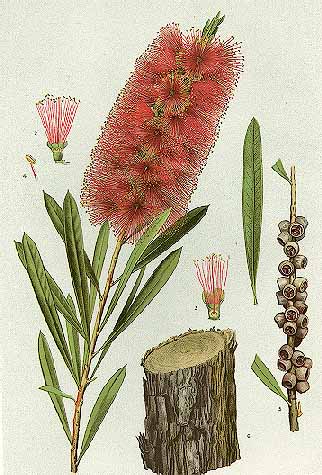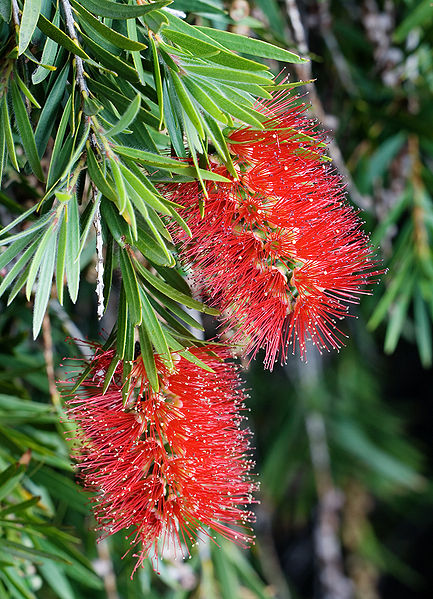 |
|
http://commons.wikimedia.org/wiki/File:Callistemon_citrinus-Minchen.jpg |
 |
| http://www.noodlesnacks.com/ |
Translate this page:
Summary
Bloom Color: Red.
Main Bloom Time: Early summer, Early spring, Late summer, Late spring, Mid summer, Mid spring. Form: Rounded, Upright or erect.
Physical Characteristics

 Callistemon citrinus is an evergreen Shrub growing to 4.5 m (14ft) by 2.5 m (8ft) at a medium rate.
Callistemon citrinus is an evergreen Shrub growing to 4.5 m (14ft) by 2.5 m (8ft) at a medium rate.
See above for USDA hardiness. It is hardy to UK zone 9. It is in leaf all year, in flower from July to August. The species is hermaphrodite (has both male and female organs).
Suitable for: light (sandy), medium (loamy) and heavy (clay) soils and prefers well-drained soil. Suitable pH: mildly acid and neutral soils and can grow in very acid soils.
It cannot grow in the shade. It prefers dry moist or wet soil and can tolerate drought.
UK Hardiness Map
US Hardiness Map
Synonyms
C. lanceolatus.
Plant Habitats
Woodland Garden Sunny Edge; Bog Garden; South Wall. By. West Wall. By.
Edible Uses
Edible Parts:
Edible Uses: Tea
The leaves are a tea substitute and have a delightfully refreshing flavour[144].
References More on Edible Uses
Medicinal Uses
Plants For A Future can not take any responsibility for any adverse effects from the use of plants. Always seek advice from a professional before using a plant medicinally.
None known
References More on Medicinal Uses
The Bookshop: Edible Plant Books
Our Latest books on Perennial Plants For Food Forests and Permaculture Gardens in paperback or digital formats.

Edible Tropical Plants
Food Forest Plants for Hotter Conditions: 250+ Plants For Tropical Food Forests & Permaculture Gardens.
More

Edible Temperate Plants
Plants for Your Food Forest: 500 Plants for Temperate Food Forests & Permaculture Gardens.
More

More Books
PFAF have eight books available in paperback and digital formats. Browse the shop for more information.
Shop Now
Other Uses
Dye Wood
A tan dye is obtained from the flowers, it does not require a mordant, and is green when mordanted[168]. Other members of this genus can also be used[168]. A cinnamon dye is obtained from the leaves[168]. Other members of this genus can also be used[168]. Wood - hard, heavy, tough, close grained, but too small for economic use. Used for tool handles etc[154]. It is also used for fuel[272].
Special Uses
Espalier Scented Plants
References More on Other Uses
Cultivation details
Landscape Uses:Border, Container, Espalier, Pollard, Screen, Standard, Specimen. Succeeds in any soil, tolerating both water-logging and drought[260]. Requires a fertile well-drained moisture retentive soil in full sun[200]. Succeeds in a hot position in dry soils. Accepts very wet conditions in Australian gardens[157]. Prefers an acid soil, not doing very well on chalk[182]. This species requires cold greenhouse treatment in most of Britain but it is possibly hardy in the milder areas of the country although even there it is best grown against a wall[1, 11]. Plants are hardy to at least -7°c in Australian gardens[157]. Another report says that it tolerates temperatures down to about -10°c in Britain[184] and grows well in warm positions in southern gardens. Small-leaves forms of the plant are hardier than the type and can tolerate temperatures down to about -10°c[260]. The cultivar 'Splendens' is said to be particularly good in Britain and is possibly more hardy than the type[202]. Plants are very tolerant of pruning, even old plants will regenerate if pruned back hard into the old wood[K]. The species C. linearis, C. rigidus and C. subulatus are all closely allied to this species and are somewhat hardier[11]. Hybridizes freely with other members of this genus[200]. The leaves vary considerably in shape and are lemon scented[182, 184]. The leaves, when pressed, emit a refreshing scent of lemon[245]. Plants in this genus are notably resistant to honey fungus[200]. Special Features:Attracts birds, Not North American native, Attracts butterflies, Blooms are very showy.
References Carbon Farming Information and Carbon Sequestration Information
Temperature Converter
Type a value in the Celsius field to convert the value to Fahrenheit:
Fahrenheit:
The PFAF Bookshop
Plants For A Future have a number of books available in paperback and digital form. Book titles include Edible Plants, Edible Perennials, Edible Trees,Edible Shrubs, Woodland Gardening, and Temperate Food Forest Plants. Our new book is Food Forest Plants For Hotter Conditions (Tropical and Sub-Tropical).
Shop Now
Plant Propagation
Seed - surface sow in February in a shaded part of the greenhouse[78]. Cover with paper and stand the pots in a few centimetres of water until germination takes place[200]. Remove from the water tray as soon as the seed germinates. Seedlings are prone to damp off and must be watered with care and kept well ventilated[200]. When large enough to handle, prick the seedlings out into individual pots and grow them on in the greenhouse for at least their first winter, planting them out into their permanent positions in late spring or early summer, after the last expected frosts. Cuttings of half-ripe wood,7 - 10cm with a heel, July/August in a frame. Poor results[78].
Other Names
If available other names are mentioned here
Native Range
AUSTRALASIA: Australia (New South Wales (east), Queensland (east), Victoria (east))
Weed Potential
Right plant wrong place. We are currently updating this section.
Please note that a plant may be invasive in one area but may not in your area so it's worth checking.
Conservation Status
IUCN Red List of Threatened Plants Status :

Growth: S = slow M = medium F = fast. Soil: L = light (sandy) M = medium H = heavy (clay). pH: A = acid N = neutral B = basic (alkaline). Shade: F = full shade S = semi-shade N = no shade. Moisture: D = dry M = Moist We = wet Wa = water.
Now available:
Food Forest Plants for Mediterranean Conditions
350+ Perennial Plants For Mediterranean and Drier Food Forests and Permaculture Gardens.
[Paperback and eBook]
This is the third in Plants For A Future's series of plant guides for food forests tailored to
specific climate zones. Following volumes on temperate and tropical ecosystems, this book focuses
on species suited to Mediterranean conditions—regions with hot, dry summers and cool, wet winters,
often facing the added challenge of climate change.
Read More
Expert comment
Author
(Curtis.)Skeels.
Botanical References
11154200
Links / References
For a list of references used on this page please go here
Readers comment